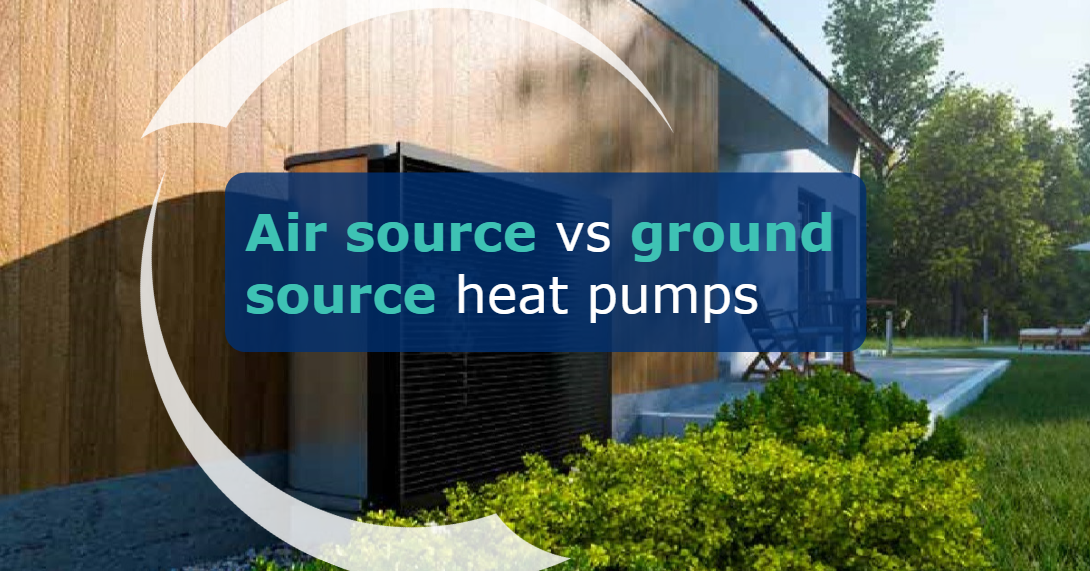The Difference Between Air Source & Ground Source Heat Pumps
If you’ve read our page on how heat pumps work, you’ll know that there are different types of heat pump.
They all work in fundamentally the same way: they extract heat from one place and move it to another (your home) – but they differ in how they extract heat and where they extract it from.
The most common types of heat pump around the world are air source and ground source. These heat pumps extract heat from either the ground or air, and transfer it to either water or air in order to heat up your home and water.
Air-to-air heat pumps are really common in North America (where they’re more commonly known as HVAC systems) because they can also cool your home in the summer, but their main drawback is that they can’t heat up water.
As such, they’re not very common at all in UK domestic properties because the vast majority are developed with water-based radiator heating – so retrofitting an air-to-air heat pump means you need to also find another way to get hot water for showers and taps.
As such, we’ll only focus on air-to-water and ground-to-water heat pumps in this article!
Here is everything we discuss:
Ground source heat pumps need a borehole
Ground source stays consistent
Boreholes can freeze the ground
Ground source heat pumps need a borehole
In order to extract heat from the ground, ground-source heat pumps need to use either a really deep borehole (sometimes as deep as 150m) or a large area of ground with a heating line snaked through it.
A glycol mixture is pumped through these lines, takes heat from the surrounding soil, and then exchanges that heat into a refrigerant line – which then follows a process much the same as that in air source heat pumps.
The heating “snake” has the benefit of not needing large boring equipment, but also takes up a lot of room – a lot of room that becomes difficult to build over in the future.
What hassle you save from the boring equipment you also create by having to excavate quite a large area of soil, placing the snake properly, and then backfilling carefully so as to not damage any of the lines. It’s possible to do this with micro excavators, but is a much faster job with a good sized digger.
On the other hand, boring equipment is necessarily quite large, so it’s also not something you can easily do with most properties unless you happen to have a particularly large garden as well as easy access for large vehicles.
You also sometimes need to have multiple boreholes drilled in order to get enough heat for your property – which makes costs and installation time increase quite a bit.
Ground source stays consistent
A key (perceived) benefit for ground source heat pumps is that the ground tends to stay at a relatively consistent temperature – but heat pumps operate more effectively through creating larger differences in temperature between the internal refrigerant and the source of heat.
Importantly, the ground tends to stay at an even temperature because (depending on how moist it is) it’s not a great conductor of heat – so it takes longer to replenish any heat you extract.
Boreholes can freeze the ground
This isn’t necessarily a problem if you live in a hot area with abundant heat – but is likely to become an issue if you live somewhere that regularly sees frost (like the UK).
When the ground freezes around a borehole, you’re no longer able to extract heat from it until it thaws and it can, in some instances, damage the borehole itself – which then requires drilling a whole new borehole.
Air source heat pumps cut out the long glycol lines
Air source heat pumps have the great benefit of cutting out the large, cumbersome glycol lines; rather than having to run glycol through huge lengths of pipe within the heat source in order to then heat up a refrigerant, ASHPs simply draw the “source” directly over the refrigerant line.
By pulling air over a supercooled refrigerant line, the heat from the air passes into the refrigerant and is then transferred into your hot water tank.
The key benefits here are that you don’t need bulky diggers and expensive boring equipment to install an air source heat pump – but also that there’s no danger of freezing the soil and rendering your heat pump temporarily (or permanently) inoperable.
Which one is more efficient?
Both types of heat pump operate at similar system efficiencies when properly installed, but ground source heat pumps are much more difficult to re-size, fix, and maintain if they’ve been installed wrongly or the system’s been sized wrongly.
With an undersized ASHP system, you can often simply add another heat pump – if you’re stuck with an undersized ground source heat pump, it’s quite an ordeal to “simply” add another borehole!
There’s also the question of the transfer of energy: whenever energy is transferred from one medium to another, there’s almost always a loss of energy. So there’s not an insignificant amount of energy lost in the transfer from glycol to the refrigerant in a ground source line.
ASHPs only have one transfer in the extraction process – directly from the air to the refrigerant – so they’re able to carve out even more efficiency.
Considering a heat pump?
If you’re considering upgrading to sustainable, dependable heating for your home and water, talk to one of our experts to have any questions answered!



